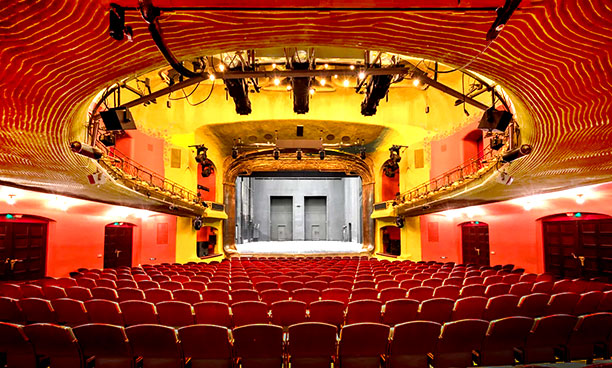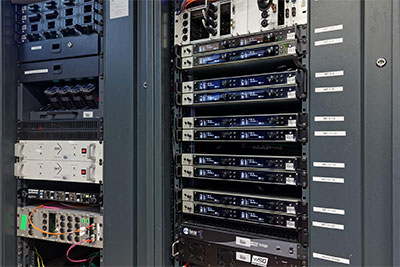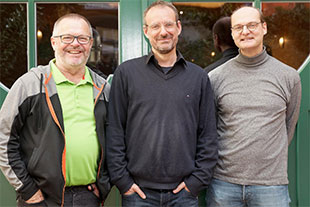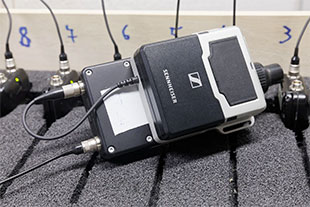
Like many of his colleagues, tonmeister Wolfram Schild – Head of Audio at the Munich Kammerspiele, where he has worked for more than 20 years – uses the Sennheiser term Mikroport whenever he refers to wireless audio.
‘We have been using wireless systems from Sennheiser in our theatres for more than two decades now,’ he says. ‘In the meantime, our analogue wireless channels have largely been replaced by modern digital versions. At the Schauspielhaus venue, we replaced the products from the Sennheiser 5000 series with Digital 6000 systems around three-and-a-half years ago. We carried out a similar upgrade at the Therese-Giehse-Halle in summer 2021.
‘The Sennheiser 5000 series is fantastic and pretty much indestructible, but the increasing use of the available frequency spectrum has been causing us more and more headaches in recent years. Our theatres are located in the centre of Munich and if one of the nearby hotels is holding a major event and using a lot of wireless systems, we soon notice it. For that reason, we looked for a wireless system that is freely tuneable and resistant to interference from other users.’
 The Munich Kammerspiele theatre company operates four performance venues. The main stage is the Schauspielhaus, a single-storey gallery theatre. The second-largest is the Therese-Giehse-Halle, named after the legendary German actress. The third is the Werkraum, with almost 50 years of history. And, under the leadership of the current director, a section of the Maximilianstraße venue that was previously used as a box office has been converted into what is now called the Habibi Kiosk.
The Munich Kammerspiele theatre company operates four performance venues. The main stage is the Schauspielhaus, a single-storey gallery theatre. The second-largest is the Therese-Giehse-Halle, named after the legendary German actress. The third is the Werkraum, with almost 50 years of history. And, under the leadership of the current director, a section of the Maximilianstraße venue that was previously used as a box office has been converted into what is now called the Habibi Kiosk.
The Habibi Kiosk aims to offer a melting pot for multinational communication and culture, and is used for holding discussion groups in cooperation with the Goethe Institute, for producing radio programmes and for staging concerts – which is why it is now dubbed the fourth stage of the Munich Kammerspiele.
‘We are quite clearly a modern theatre of the spoken word and our repertoire is also aimed at a comparatively young audience,’ Schild says.
In this, he is assisted by sound engineer/musicologist Johann Jürgen Koch and Martin Sraier, who has also gained a reputation among colleagues as an IT expert – a skill often called on for the theatre’s Dante network, which enables digital audio signals to be distributed the various locations. The Dante network also links to an editing suite and all of the control rooms, which are equipped with Salzbrenner digital consoles.
According to Schild, the search for a digital wireless mic solution was ‘open to all results’, but practical tests delivered a unanimous preference for Sennheiser’s Digital 6000. The analogue Sennheiser wireless systems previously employed were not sold off following the refit, but are now used for the rehearsal stages.
At the Schauspielhaus, 20 digital wireless channels can now be used for performances. At the Therese-Giehse-Halle, 12 digital wireless channels are available, and at the Werkraum venue, components from the analogue Sennheiser ew 500 G3 series provide eight channels, although a changeover to digital systems in the near future is already being contemplated. ‘Eight channels are definitely not enough for the Werkraum in the meantime,’ Schild says, adding that the venue is often affected by external interference.
 The 32 digital channels available at the Munich Kammerspiele are used with ultra-compact SK 6212 bodypack transmitters. Four SK 6000 are also available, and are used in combination with an adapter to enable conventional microphones to be operated wirelessly in a similar way to using an SKP plug-on transmitter. This special solution (P48 Phantom Power Adapter for SK 6000/9000) with an XLR connector and lock ring provides 48V phantom power and in the meantime is also available with the much smaller SK 6212.
The 32 digital channels available at the Munich Kammerspiele are used with ultra-compact SK 6212 bodypack transmitters. Four SK 6000 are also available, and are used in combination with an adapter to enable conventional microphones to be operated wirelessly in a similar way to using an SKP plug-on transmitter. This special solution (P48 Phantom Power Adapter for SK 6000/9000) with an XLR connector and lock ring provides 48V phantom power and in the meantime is also available with the much smaller SK 6212.
The microphones in use at the Munich Kammerspiele are predominantly omnidirectional Sennheiser MKE 1. Sennheiser SL Headmic 1 SB headworn condenser microphones are also available and are stored in rack drawers with specially designed foam inserts.
In addition to the bodypack transmitters, the Schauspielhaus has eight SKM 6000 handheld transmitters. Six SKM 6000 are available in the Therese-Giehse-Halle. The handheld transmitters are all fitted with super-cardioid Neumann KK 205 condenser capsule heads.
‘In terms of the robustness of the handheld and bodypack transmitters, we have only had positive experiences so far,’ Schild says. ‘The professional systems from the Sennheiser portfolio have always proven themselves in tough everyday use in the theatre, and the Digital 6000 systems are no exception in this respect. And if any problems do occur, we can turn to the Sennheiser service team in Barleben, who always help us quickly and competently.’
All Sennheiser EM 6000 receivers at the Munich Kammerspiele have a redundant connection via a primary and secondary port to the theatre’s existing Dante network. Additional operational reliability is provided by the fact that the port outputs are routed separately via different switches. According to Schild, the overall latency of the digital audio network remains within an acceptable range, in spite of complex FIR filtering of the loudspeaker system, and it is not noticeable during live performances.
Audio is mixed using Polaris evolution systems from Salzbrenner media GmbH. The can use an add-on that enables selected parameters of the Sennheiser wireless systems (2000 series, 6000 series, 9000 series) to be displayed on their touchscreen, as would otherwise be possible on external monitors using the WSM (Wireless Systems Manager) software.
‘It’s incredibly useful to have information such as the remaining battery life or the AF and RF levels displayed directly on the corresponding mixing console channel,’ Schild says. Due to these convenient control possibilities directly at the console, the WSM software is now used only occasionally in the theatre.
‘Battery technology has seen an incredible amount of new development in recent years,’ he adds. ‘We have two rechargeable batteries for each of our handheld and bodypack transmitters, which means that one of the two batteries is always in the charger. We are using L 6000 charging stations with three different charging modules for small and large bodypack transmitters and for the handheld transmitters.
 ‘This is the first time I’ve been able to use batteries in live performances with a clear conscience and without having to worry about them. In the past, we mainly used non-rechargeables that were certainly not the ideal solution from an environmental perspective – we had to dispose of heaps of used batteries every month.’
‘This is the first time I’ve been able to use batteries in live performances with a clear conscience and without having to worry about them. In the past, we mainly used non-rechargeables that were certainly not the ideal solution from an environmental perspective – we had to dispose of heaps of used batteries every month.’
The Digital 6000 systems at the Munich Kammerspiele were supplied by system providers, and the wireless equipment was installed by the theatre’s own audio department. The main contact partner on behalf of Sennheiser is Roland Bachmann (Account Manager, Pro AV): ‘We need to pay particular attention to ensuring reliable wireless transmission of audio signals, particularly in densely populated inner-city areas like the centre of Munich,’ he explains. ‘The Digital 6000 systems are perfectly equipped to meet the challenges of today and tomorrow. Their groundbreaking technology enables us to fit significantly more wireless channels into a smaller frequency spectrum than was possible in the past. A particular benefit is the possibility to arrange transmission frequencies in an equidistant grid with a minimum spacing of 400kHz. And in situations that require Link Density mode, it is possible to accommodate up to 40 links with a spacing of 200kHz in an 8MHz-wide TV channel.’
‘Ever since we started using Sennheiser Digital 6000, we haven’t had any problems with external interference at our performance venues,’ Schild says. ‘I find the new systems totally convincing, especially because their range is really good – the wireless connection is absolutely stable even over larger distances at our performance venues.’ The Sennheiser Digital 6000 systems at the Munich Kammerspiele are operated in the A1–A4 (470-558MHz) frequency range. Active AD 3700 broadband directional antennas are installed.
The audio benefits of digital wireless transmission include lower noise compared to analogue transmission. ‘The digital transmission sounds incredibly clean, even when a lot of channels are open,’ Schild confirms. ‘In addition, as an audio producer you have an amazing amount of headroom available, which is very convenient in our everyday production work with different sound engineers because it lets you work with standardised gain settings. In the meantime, we only really need to change the gain parameters if, in exceptional cases, we have to transmit a line signal instead of a mic level. In my opinion, digital Sennheiser wireless technology is far superior to analogue transmission concepts in practically every respect.’

